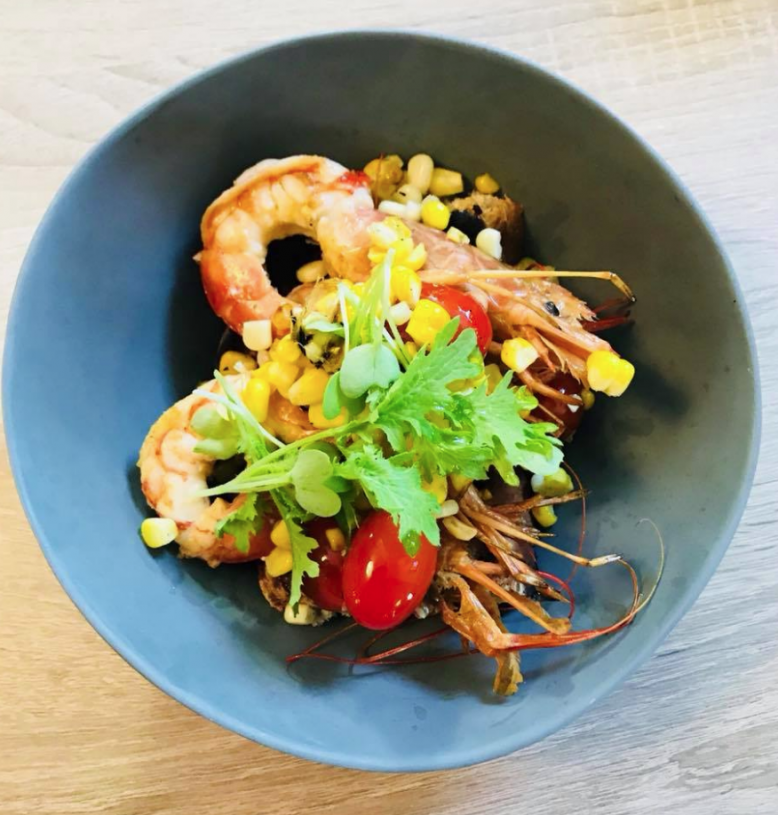


Despite its shift from farmland to sprawling suburb after World War II, Cherry Hill retains some of its historic farmhouses. An 1859 specimen that for years held La Campagne, which closed in 2012, was bought in 2016 and renovated last year by South Jersey native Stu Wanicur, a corporate food-service professional who had long dreamed of owning his own restaurant. Now the Farmhouse, it has four small dining areas, with farm tools and paintings of root vegetables on the muted walls, plus a large outdoor patio.
To distinguish Farmhouse from the many Italian and chain restaurants in the area, Wanicur tapped local farms and waters for produce and seafood. Settling on a signature cooking style has proven to be a bit more challenging.
Eight months after the 90-seat restaurant’s May 2017 opening, chef David Murray left for another opportunity. He was replaced by Bruce Santino, a graduate of the Restaurant School at Walnut Hill College in Philadelphia, who had been selling Wanicur berries and mushrooms he had foraged. With Santino, Wanicur says the restaurant is attempting “to elevate everything—service, food, presentation. It’s a little more upscale.”
That has meant changing the price of the three-course tasting menu, originally $42. It now varies depending on entrée, from $41 for chicken breast to $53 for filet mignon. Wanicur says about 80 percent of customers dine prix fixe.
I visited the restaurant under Murray and found much of his Southern-inspired comfort foods overly sweet, like densely crusted cornbread topped with maple syrup and thick Duroc pork chops with cloying whipped sweet potatoes, Santino’s touch is so light it is almost undetectable. He calls his cooking “French inspired with American ingredients. I don’t like to do a whole lot of craziness with food. Just leave it in its natural state and let it shine in season.”
A few popular dishes remain, including buttermilk-battered fried green tomatoes, crunchy yet supple, and the wedge salad with chopped egg, tomatoes and bacon, now with a truffled blue cheese dressing rather than French dressing. He added a beet salad with goat cheese mousse and a mixed green salad with acorn squash and manchego. Underneath their toppings, they were disturbingly similar, both piled with frisée, radicchio and dandelion greens in a barely discernible roasted-honey dressing.
Appetizers fared somewhat better, including tasty fried Cornish game hen over fluffy chickpea waffles with braised Swiss chard. Shrimp and grits featured red spot prawns, but the slightly mealy grits needed more flavor than the splash of shrimp-coffee stock could provide.
Australian lamb sirloin was thick and tender in a reduction of lamb stock and huckleberries that Santino foraged in Princeton last summer and froze. It came with grilled carrots and a goat-cheese polenta that tasted suspiciously familiar. Santino acknowledged they were the same grits used in the shrimp and grits, with the goat-cheese mousse from the beet salad mixed in.
A flavorful veal chop was nearly lost in the heavy fried coating of panko crumbs, parsley and garlic. The menu said it came with seasonal greens. Since this was an entrée, I assumed the greens would be cooked, but they were the same greens we had already encountered twice, again served as a salad, this time with pickled carrot, radish and fennel.
Santino doubles down on desserts. His peanut butter and jelly panna cotta lacked any panna cotta delicacy, replaced by a heavy peanut butter pudding topped with blackberry jam and fried brioche. The chocolate lover’s trifle was gloppy, a collision of chocolate mousse, chocolate layer cake and chocolate ganache. The fried tapioca balls sprinkled on top provided much-needed contrasting crunch, but no relief for the one-dimensional, kiddie-corner concept of flavor.
Restaurant Details
- Cuisine Type:American - Modern
- Price Details:Appetizers, $9-$14; entrées, $24-$39; desserts, $9-$11; tasting menus, $42, $60
- Ambience:Stately, historic home
- Service:Helpful and informed
- Wine list:BYO
